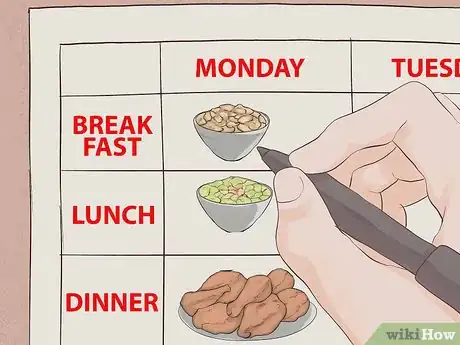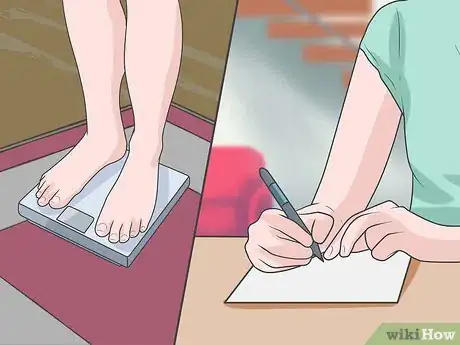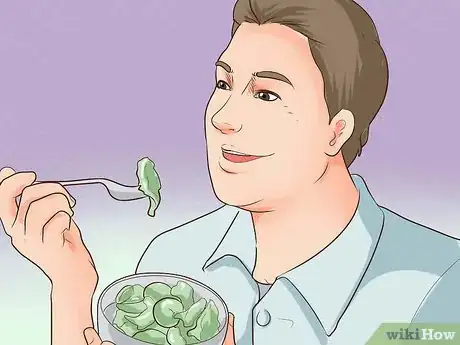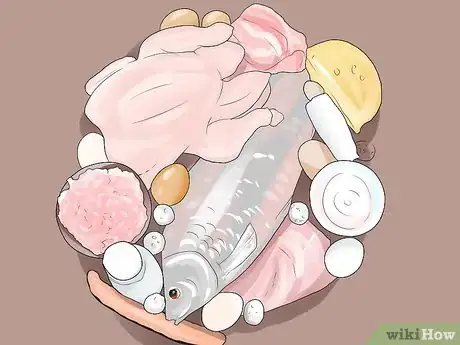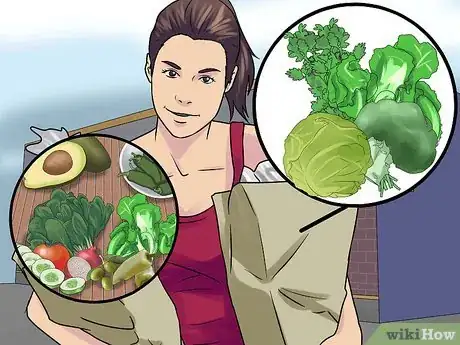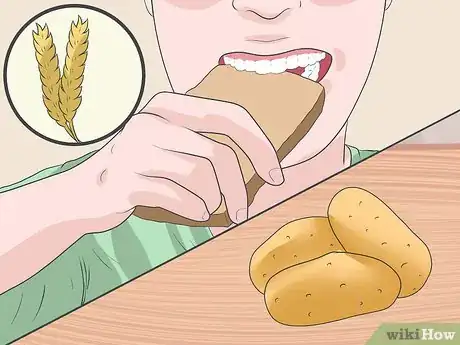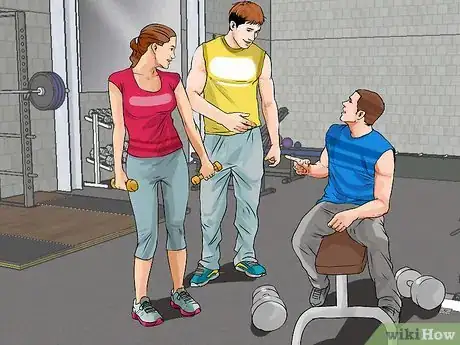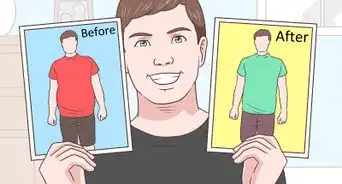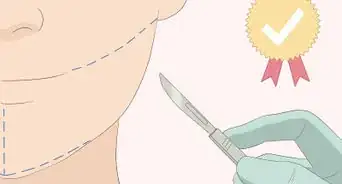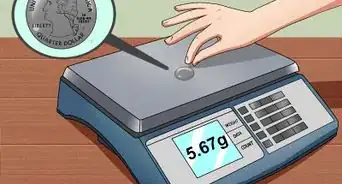This article was co-authored by Laura Flinn. Laura Flinn is a National Academy of Sports Medicine (NASM) Certified Personal Trainer, USA Olympic Weightlifting Sports Performance Coach and Certified Fitness Nutritionist, with an additional qualification as a TRX Suspension Trainer. Laura runs her own personal training program based in the San Francisco Bay Area and specializes in topics such as weight loss, muscle growth, cardiovascular training, and strength training.
There are 21 references cited in this article, which can be found at the bottom of the page.
This article has been viewed 23,795 times.
Losing weight can be difficult — especially if you do it alone. If you partner up with someone, it can make it a little more fun to lose weight. Many studies have shown that those who have a support group or support person during weight loss have an easier time losing more weight and keeping it off long-term.[1] If you and your partner both need to lose weight, consider doing it together. You'll have the support of each other and can use each other to stay motivated and accountable. Set up a weight loss plan together to help you both get down to a healthy weight.
Steps
Preparing for a Joint Weight Loss Plan
-
1Design a healthy eating meal plan together. One of the first things you and your partner need to do is design a meal plan together. This is when you'll decide what you're eating, how often and choose recipes.[2]
- Studies have shown that more structured meal plans are more effective at helping people lose weight.[3]
- Sit down together and write out a week's worth of meals. Make sure that both of you agree on what you're choosing — especially for the meals you're planning on eating together (like dinner).
- Write out every breakfast, lunch, dinner and snack meal that you will include over the next week. This can help give you structure and a blueprint of how to eat. Plus it can help you come up with your grocery list.
-
2Figure out how much weight you want to lose. Another important task that both of you need to do is determine how much weight you need to lose. This will help both of you set your goals and pick a diet that can help you achieve this loss.
- When you're trying to lose weight, you need to aim for a healthy weight for your gender, age and height. Use your BMI as a starting point to determine how much weight you want to lose.[4]
- Use an online BMI calculator to calculate your BMI, which should tell you if you are underweight (BMI under 18.5), a healthy weight (18.5 to 24.9), overweight (25 to 30), or obese (over 30).
- You can also calculate your BMI yourself with these equations:
- For English-Imperial calculations, use BMI = ( Weight in Pounds / ( Height in inches x Height in inches ) ) x 703.
- For metric calculations, use BMI = ( Weight in Kilograms / ( Height in Meters x Height in Meters ) ).[5]
Advertisement -
3Set goals together. One of the best parts about losing weight together as a couple is that you can set goals together, support each other, and see each other progress as you both lose weight and are successful.
- When both of you begin setting your weight loss goals, make sure they're realistic for you. If you have a large amount of weight to lose or want to lose weight quickly, this might not be possible initially.
- For example, health professionals recommend only aiming to lose about 1 to 2 pounds (0.45 to 0.91 kg) pounds per week. So if you need to lose 15 pounds (6.8 kg), aiming to lose that within 3 weeks is not realistic or safe.[6]
- If you do have larger weight loss needs, considering setting multiple goals. Your first goal may be to lose 10 pounds (4.5 kg) and then your second goal may be to lose the last 8 pounds (3.6 kg).
- Also set a goal ending point together. You might have different amounts of lose, but your goal "check-in" day is the same. You might want to lose 10 pounds (4.5 kg) in 2 months and your partner might want to lose 15 pounds (6.8 kg) in that same time period.
- Setting that goal point together can help both of you stay on track and push each other as you near your goal.
-
4Find measures of accountability for each other. A point where some dieters go awry with weight loss, is not staying accountable. However, when you have a partner to lose weight with, setting methods of accountability will help both of you stay successful over time.
- Measures of accountability are things you should do regularly, and usually for the rest of your life, to make sure you meet your weight loss goals and then keep the weight off long-term.[7]
- Both of you should pick a day during the week where you both hop on the scale. Studies have shown that people who weigh in regularly are able to be more successful long-term.[8]
- Consider keeping a food diary. This can help you stay accountable day to day. But if you're having trouble losing weight or are gaining a little bit, your partner can look over your food journal (or gently remind you) of times you've overeaten or snacked a little too often.
- A trick is to save a pair of "skinny" jeans or pants. Pick out a pair for each other and keep these in your closet. Anytime you need a quick reminder pull those on.
Following a Healthy Diet and Lifestyle Together
-
1Measure your portions. When you're trying to lose weight, alone or with a partner, portion sizes are a key part of making sure your diet helps support your desired weight loss. Both of you can help each other stick to proper portion sizes to help you lose weight.
- If your portions are too big, even of more nutritious foods, it could still be too many calories for your body weight. Measuring portions regularly can help you stay on track.[9]
- A great thing about losing weight with a partner is that you can measure out portions for each other. It's hard to stick to smaller portions and too easy to add a little bit too much to your plate.
- However, if you have your partner measure your portions, they'll be able to give you the exact amount for you without being influenced by your thoughts. You should measure out the appropriate portion for your partner and vice versa.
-
2Prepare lean protein sources you both enjoy. When both of you are coming up with your meal plan, you'll need to select protein sources to include in your meals. Protein is essential to weight loss, so both of you will need to focus on this nutrient in your diet.[10]
- Protein is not only an essential nutrient for your body, it's also important in the weight loss process. It helps support your lean muscle mass, metabolism and fuels your body through the day.[11]
- Protein also takes a longer time to digest in your stomach. This leaves you feeling more satisfied longer compared to other nutrients like carbohydrates.
- Work together to make sure both of you are eating protein at every meal. You should aim for at least one to two servings of protein at each meal. Measure out 3 – 4 oz (85 – 113 grams) of protein per serving.[12]
- Stick to lower calorie lean protein sources like: poultry, eggs, low-fat dairy, lean beef, lean pork, legumes or tofu.
-
3Stock up on plenty of fruits and vegetables. Both of you will also need to focus on consuming adequate fruits and vegetables during the day. Like protein, these foods will really help your weight loss efforts.[13]
- Both fruits and vegetables should make up about half of your meals and snacks when you're trying to lose weight. This is because both of these foods are naturally lower in calories, which helps make half of your meal lower in calories.[14]
- Fruits and vegetables also help keep you satisfied longer. They're bulky and full of fiber which helps bulk up the volume of your meals (without a lot of calories) and keeps you satisfied longer.
- Measure out a serving of fruit or vegetables at each meal. Go for 1/2 cup of fruit, 1 cup of vegetables or 2 cups of leafy greens per serving.[15] [16]
-
4Make your grain choices 100% whole grain. During weight loss, cutting back slightly on your grain intake can make weight loss go a little faster and make it a little easier; however, when you're choosing to eat a grain, go for 100% whole grain items.
- Studies have shown that when you limit carbohydrates, especially from carb-rich foods like grains, you lose weight a little more quickly compared to other types of diets (like low calorie only or low fat only).[17]
- Grains are very high in carbs so moderate how much of these you eat when you're trying to lose weight.
- Include a serving daily if you'd like. Measure it out so you keep your intake to a minimum. Serving sizes depend on the type of grain, so make sure you read the packaging on your foods. For instance,1 slice of bread is usually 1 serving, and 1 cup of cooked long grain brown rice is equivalent to 2 servings.[18]
- Also, choose 100% whole grains since these are less processed and higher in fiber. Go for brown rice, quinoa, whole wheat bread, whole wheat pasta or whole wheat English muffins.
-
5Help each other limit snacking. One of the downfalls of many dieters is snacking. Too many little slip ups throughout the day or after dinner can cause a weight plateau or even a weight gain.[19]
- The occasional snack, especially when eaten appropriately, won't harm your weight loss; however, mindless snacking or grabbing higher calorie snacks can lead to weight gain.
- Snack only if you're truly hungry and your next planned meal isn't for another hour or 2. Also, keep snacks to about 150 calories total so they don't burst your calorie budget.[20]
- If you see your partner going for a snack after dinner or more often than they should, gently remind them to stay on track with you.
-
6Find ways to stay active together. In addition to diet, including regular exercise will help support your weight loss and weight maintenance. Staying active with your partner makes exercise a little more easy to do.[21]
- Studies have shown there are many benefits to working out with your partner. First off, you're more likely to stick to your workout routine if you know someone else is counting on you.[22]
- In addition, bringing your partner along may help you workout a little harder and a little longer as well.
- Both of you should aim for 150 minutes of cardio exercises each week in addition to 2 to 3 days of strength training.[23] Find days and times when you can go together and do an activity together.
Maintaining a Team Approach for Success
-
1Be patient. One of the most important things when tackling weight loss together as a couple is being patient with each other. You won't agree on everything as you begin your weight loss journey together, so try to stay patient with each other.
- Whether or not you're trying to stay positive as your partner loses more weight than you or chooses a dinner recipe you're not a fan of, being patient can help you stay bonded during this time.
- If you're constantly arguing or disagreeing about things, you'll forfeit all the benefits that come with losing weight together. Stay patient with each other so that you can continue to reap all those great weight loss benefits you can reach as a team.
- On the same note, you'll need to make compromises when you're losing weight together. You'll have to alternate between the 2 of you who is holding the reigns.
-
2Don't compare yourselves. Although a little competition can be motivating and encouraging, it can also cause some negative side effects. Enjoy playful competition but keep it tame.
- One thing with weight loss between two people that will always be true is that someone will lose more weight or lose it faster.[24]
- Understand that if you don't lose as much weight or lost it as quickly as your partner, this doesn't mean you're not doing well or aren't successful. You're both different people and will have different results.
- Be careful when trying to motivate your partner if you are ahead of them. This could backfire and make them feel like they aren't doing well. Try to be encouraging and motivating and don't tease them.
-
3Find non-food activities to enjoy together. While losing weight together as a couple, you have each other to hang out with and you can find healthy activities you can do together.
- It can be hard to stick to a diet if your friends or family are always going out to dinner, skipping workouts or snacking. Having someone on your team can make it a lot easier to stick to your diet and healthy lifestyle.
- If you normally do a lot of food-centered activities (like going out to dinner, going to get happy hour drinks or having popcorn at the movies), find other things that you can enjoy together that don't have anything to do with food.
- For example, instead of going out to breakfast on Sunday morning, plan a morning hike. Or instead of ordering in pizza on Friday night, make your own healthier pizza at home.
-
4Cook together. A fun part of losing weight together as a couple is that you can cook and come up with healthy recipes together. This helps you stay motivated but also shares the work of healthy food prep.
- It's fun to come up with healthy recipes together. For example, if you're both cutting out excess amounts of grains, find alternatives to your favorites, like using cauliflower in place of rice.
- Make sure you find recipes and foods that you'll both enjoy and feel comfortable cooking.
- You can consider cooking together every night or alternating days when you cook so you can have some time out of the kitchen during the week.
Expert Q&A
-
QuestionWhat exercises can you use to burn belly fat?
 Laura FlinnLaura Flinn is a National Academy of Sports Medicine (NASM) Certified Personal Trainer, USA Olympic Weightlifting Sports Performance Coach and Certified Fitness Nutritionist, with an additional qualification as a TRX Suspension Trainer. Laura runs her own personal training program based in the San Francisco Bay Area and specializes in topics such as weight loss, muscle growth, cardiovascular training, and strength training.
Laura FlinnLaura Flinn is a National Academy of Sports Medicine (NASM) Certified Personal Trainer, USA Olympic Weightlifting Sports Performance Coach and Certified Fitness Nutritionist, with an additional qualification as a TRX Suspension Trainer. Laura runs her own personal training program based in the San Francisco Bay Area and specializes in topics such as weight loss, muscle growth, cardiovascular training, and strength training.
NASM Certified Personal Trainer Unfortunately, you can’t target certain areas for fat loss. A combination of clean eating, cardio and resistance exercises will burn fat over time, though. Core exercises will help tone and strengthen belly but they won’t necessarily burn fat in this area.
Unfortunately, you can’t target certain areas for fat loss. A combination of clean eating, cardio and resistance exercises will burn fat over time, though. Core exercises will help tone and strengthen belly but they won’t necessarily burn fat in this area.
References
- ↑ http://www.worldmarket.com/product/candid+moment+audin+upholstered+chair.do?page=2&from=fn
- ↑ Laura Flinn. NASM Certified Personal Trainer. Expert Interview. 18 November 2019.
- ↑ http://www.weightlossresources.co.uk/weight_loss/diet-plans-benefits.htm
- ↑ https://www.hsph.harvard.edu/obesity-prevention-source/obesity-definition/abdominal-obesity/
- ↑ http://www.bmi-calculator.net/bmi-formula.php
- ↑ http://www.cdc.gov/healthyweight/losing_weight/
- ↑ http://www.everydayhealth.com/weight-pictures/ways-to-stay-accountable-for-weight-loss.aspx
- ↑ http://www.apa.org/monitor/nov07/daily.aspx
- ↑ http://www.niddk.nih.gov/health-information/health-topics/weight-control/just-enough/Pages/just-enough-for-you.aspx
- ↑ Laura Flinn. NASM Certified Personal Trainer. Expert Interview. 18 November 2019.
- ↑ http://www.womenshealthmag.com/weight-loss/protein-weight-loss
- ↑ http://www.choosemyplate.gov/protein-foods
- ↑ Laura Flinn. NASM Certified Personal Trainer. Expert Interview. 18 November 2019.
- ↑ http://www.choosemyplate.gov/vegetables-nutrients-health
- ↑ http://www.choosemyplate.gov/fruit
- ↑ http://www.choosemyplate.gov/vegetables
- ↑ http://www.mayoclinic.org/healthy-lifestyle/weight-loss/in-depth/low-carb-diet/art-20045831
- ↑ http://www.choosemyplate.gov/grains
- ↑ http://www.prevention.com/weight-loss/weight-loss-tips/eating-mistakes-leading-weight-gain
- ↑ http://www.mayoclinic.org/healthy-lifestyle/weight-loss/in-depth/healthy-diet/art-20046267
- ↑ Laura Flinn. NASM Certified Personal Trainer. Expert Interview. 18 November 2019.
- ↑ https://www.psychologytoday.com/blog/meet-catch-and-keep/201401/5-reasons-why-couples-who-sweat-together-stay-together
- ↑ http://www.cdc.gov/physicalactivity/basics/adults/index.htm
- ↑ http://www.everydayhealth.com/news/things-you-need-know-about-losing-weight-as-couple/
